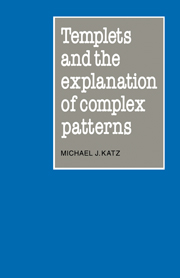Book contents
- Frontmatter
- Contents
- Prologue
- Introduction
- 1 Scientific abstractions
- 2 The nature of explanation
- 3 Configurational explanations
- 4 Templeting
- 5 Self-assembly
- 6 Rules for configurational explanations
- 7 Simple, complex and random
- 8 Reductionism
- Appendix: A pattern theoretic formalization
- Quotation index
- Subject index
- Frontmatter
- Contents
- Prologue
- Introduction
- 1 Scientific abstractions
- 2 The nature of explanation
- 3 Configurational explanations
- 4 Templeting
- 5 Self-assembly
- 6 Rules for configurational explanations
- 7 Simple, complex and random
- 8 Reductionism
- Appendix: A pattern theoretic formalization
- Quotation index
- Subject index
Summary
The notion that mice can be generated spontaneously from bundles of old clothes is so delightfully whimsical that it is easy to see why men were loath to abandon it. One could accept such accidents in a topsy-turvy universe without trying to decide what transformation of buckles into bones and shoe buttons into eyes had taken place. One could take life as a kind of fantastic magic and not blink too obviously when it appeared, beady-eyed and bustling, under the laundry in the back room.
[L. Eiseley (1957) ‘The secret of life’ The Immense Journey Vantage, NY, p. 197.]Self-assembly in general
To know a pattern is to know its roots – to understand a pattern, we must understand its history. Configurational explanations are historical explanations of pattern topology. Formally, a configurational explanation is a topologically naive automaton – a logical adder – that combines a set of raw materials and a templet to produce a final pattern. When the raw materials are topologically naive, the templet must contain significant explicit form information and the final pattern is extensively templeted. In contrast, when the raw materials are themselves topologically knowledgeable and allow the assembly of only one or a very few different configurations, the templet need not provide much additional form information and the final pattern is self-assembling.
A key and a lock, a hand and a glove, and a three-pronged plug and an electrical socket are all self-assembling units – the underlying ‘universal assembly laws’ are restrictive, and they can be fitted together in only one way.
- Type
- Chapter
- Information
- Templets and the Explanation of Complex Patterns , pp. 60 - 67Publisher: Cambridge University PressPrint publication year: 1986
- 1
- Cited by



